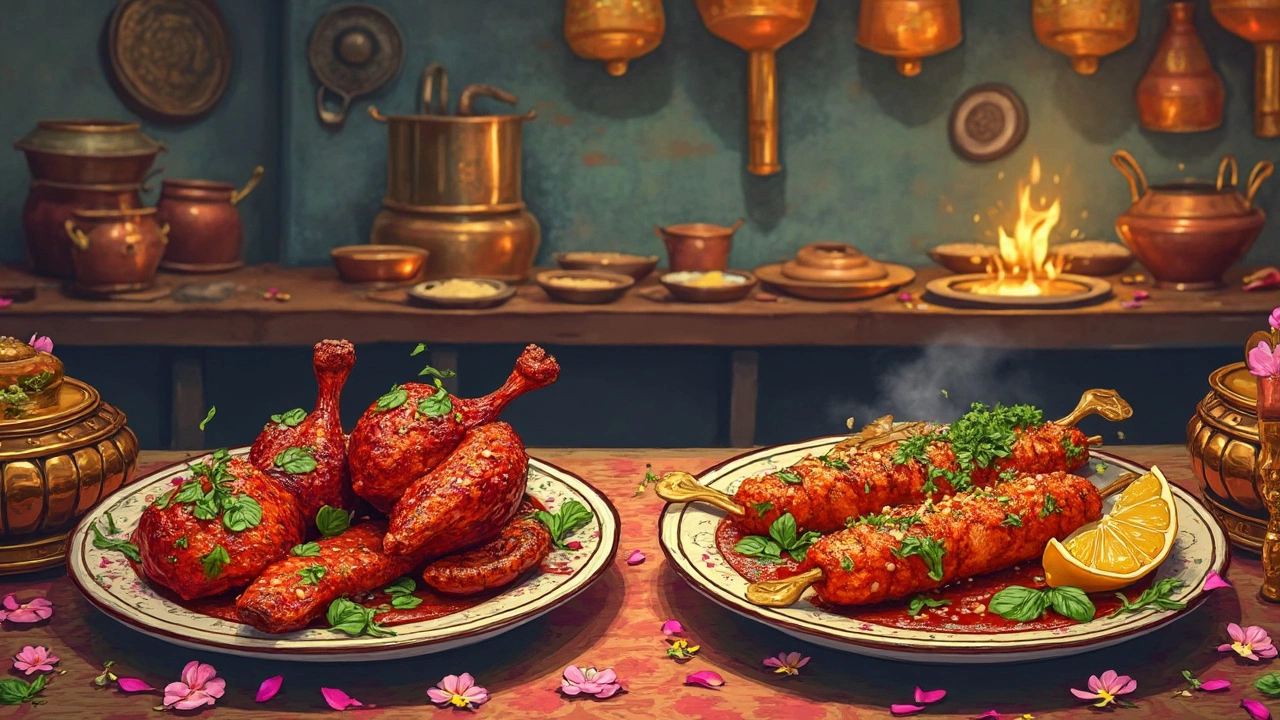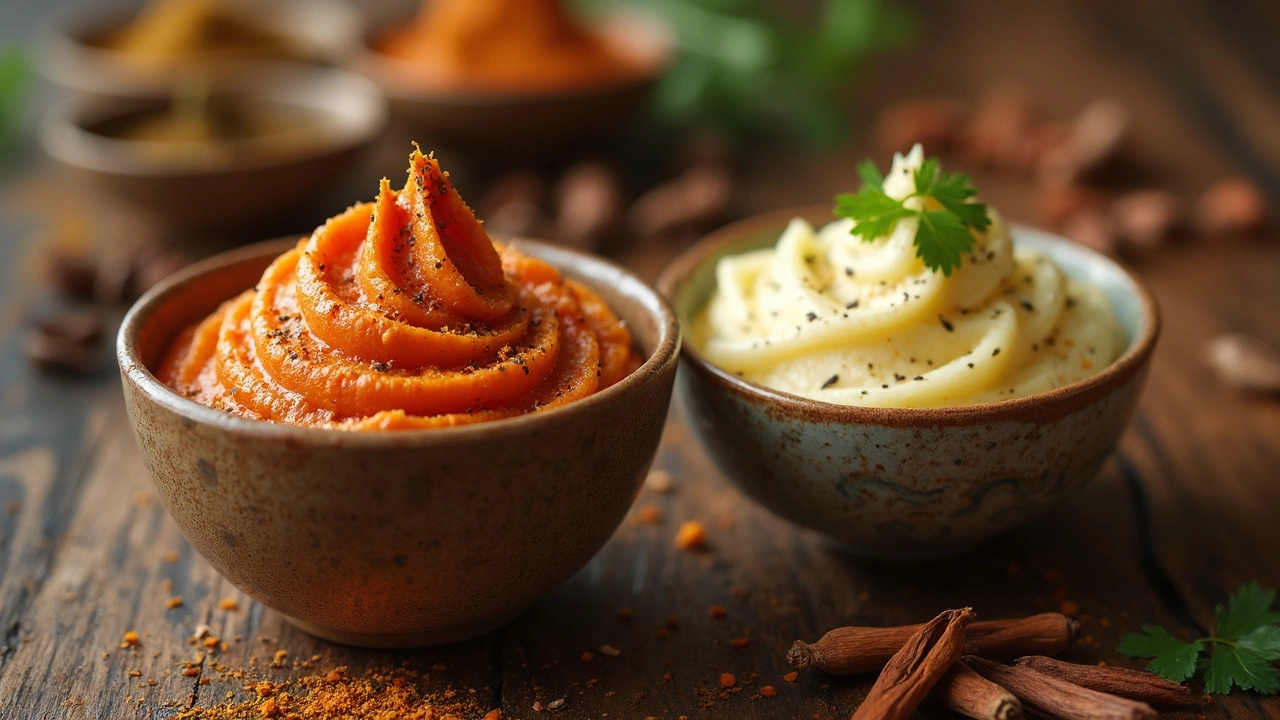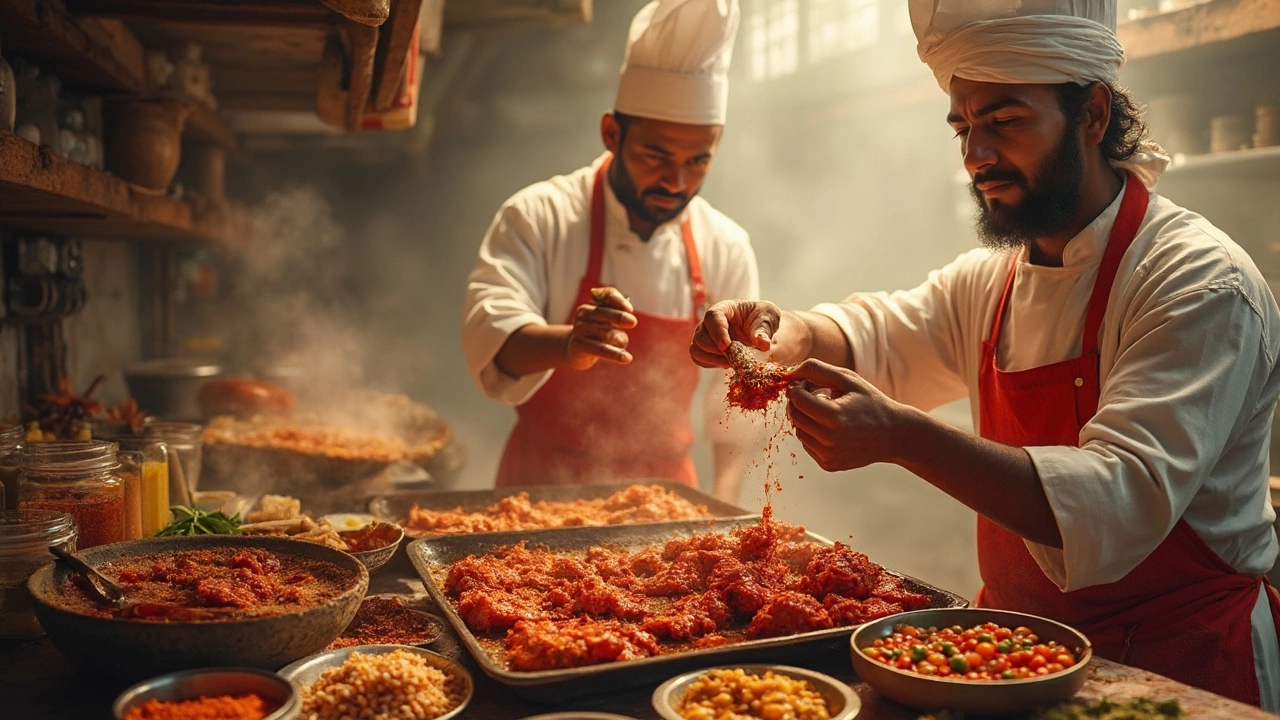So, you're looking to whip up some Indian magic in your kitchen, but you're stuck at the very first step - choosing between tandoori and tikka paste. At a glance, they might seem the same, but there's more to the story. If you're aiming for that perfect burst of spice and flavor in your dish, knowing the difference is a game-changer.
Tandoori paste is your go-to for that classic smoky, earthy sizzle people drool over when they think of Indian food. Imagine those vibrant dishes from your favorite Indian restaurant - that's what tandoori paste can do for you. It's usually red, thanks to all those spices mixed in, like cayenne pepper and red chili powder. Just a heads up, it's not shy on heat!
- The Basics of Tandoori Paste
- What Defines Tikka Paste?
- Key Differences Between Tandoori and Tikka
- Cooking Tips for Using These Pastes
- Pairing Dishes with Tandoori and Tikka Flavors
The Basics of Tandoori Paste
Alright, let's get into what makes tandoori paste so special. It's the secret behind those deep red, tangy, and smoky flavors that make tandoori dishes irresistible. Originating from the Indian subcontinent, this paste is a blend of spices that transforms simple ingredients into unforgettable dishes.
The core components of tandoori paste usually include spices like cumin, coriander, and most importantly, chile powders, such as cayenne or Kashmiri red chili, which give it that iconic deep color. Garlic, ginger, and paprika also join the party, bringing their unique flavors to the table. If you've ever tried to replicate that smoky flavor from a restaurant, that's the paprika doing its magic.
But what's a spice mix without a bit of sourness? That's where lemon juice or vinegar comes in. It enhances the flavors and acts as a tenderizing agent when you're planning to marinate meats. This paste isn't just about the spices, though. The creamy element typically comes from yogurt, which binds everything together and turns it into the rich, smooth paste that clings perfectly to whatever it's seasoning.
Speaking of seasoning, tandoori paste is insanely versatile. Use it as a marinade for meats like chicken, paneer, or even veggies. Traditionally, these marinated goodies are cooked in a tandoor, but don't worry if you don't have one. Your regular oven or even grill can do a decent job too.
And if you love experimenting, try making your own paste at home. Sure, buying it off the shelf is convenient, but whipping up your batch lets you tweak the heat or sweetness until it's just right for your taste buds.
The next time you're planning a DIY Indian feast, remember that tandoori paste isn't just for chicken. Adventure a little and let its rich, smoky taste elevate your dishes. The magic really kicks in when you see how this simple paste can bring a touch of India to your kitchen.
What Defines Tikka Paste?
Tikka paste is the secret behind those juicy, flavorful bites of chicken or veggies that you get in tikka dishes. It's not just about turning food orange. There’s a blend of spices in here that gives tikka its special zing. Unlike the heavy-duty smoking you associate with tandoori paste, tikka is more about the concentrated flavors of spices harmoniously coming together.
The typical tikka paste starts with a base of yogurt, which helps keep your meat or veggies tender while they cook. Then comes an aromatic mix of spices - think cumin, coriander, garlic, ginger, and garam masala. This concoction works wonders in marinades, infusing food with complex flavors in every bite.
Chef Sanjeev Kapoor, a renowned name in Indian cuisine, says, "Tikka paste transforms ordinary ingredients by layering them with warmth and richness, making every bite a celebration of flavors."
Tikka paste might not have the same fiery heat as tandoori, but that's the beauty of it; you can really taste the individual spices. Whether you’re using it for chicken, paneer, or even tofu, it’s all about creating that depth of flavor that makes you go back for another serving. Unlike tandoori’s more stringent nature, tikka is slightly milder, making it versatile for different palates and cabbage as well.
While preparing tikka paste, it's crucial to allow your chosen protein to rest and soak up the marinade. A good few hours in the fridge should do the trick, but if you're in a rush, even a quick half-hour can work wonders.
If you’re comparing notes on calories, here’s something interesting:
| Type of Paste | Calories per Serving |
|---|---|
| Tandoori Paste | 80 |
| Tikka Paste | 60 |

Key Differences Between Tandoori and Tikka
Alright, let's break it down. The main difference between tandoori paste and tikka paste isn't just in their flavor profiles, but also in their intended use. They're like cousins in the spice world, but each brings its own party to the table.
Tandoori paste is traditionally used for cooking meats in a tandoor, which is a special clay oven. It's all about that smoky, robust flavor, thanks to spices like cumin, coriander, and a good amount of chili. It's not just about heat; it's about that earthy warmth that makes your taste buds dance. Plus, it's perfect for meat because the thick yogurt base helps tenderize the proteins.
On the other hand, tikka paste is often used for marinating smaller pieces of meat, like chicken tikka, and even vegetables. While it shares some spices with tandoori paste, it usually includes more ingredients like tomatoes and sometimes extra lemon juice for that tangy kick. This paste leans more towards a spicier and zestier profile, making it ideal for those juicy grilled bites.
Think of tandoori as your main dish star and tikka as its lively appetizer sidekick. This isn't to say you can't swap them in a pinch; just expect a bit of twist in flavors.
| Feature | Tandoori Paste | Tikka Paste |
|---|---|---|
| Main Ingredients | Yogurt, chilies, cumin | Tomatoes, chilies, lemon |
| Common Uses | Whole meats, tandoor cooking | Smaller pieces, grilling |
| Flavor Profile | Smoky, earthy | Tangy, spicy |
Remember, the magic really happens when you choose the right paste for the right dish. Whether you're going for that big, bold tandoori flavor or the vibrant punch of tikka, now you've got the inside scoop to make your dish unforgettable!
Cooking Tips for Using These Pastes
Okay, you're armed with your tandoori paste and tikka paste, but now what? Don't worry, cooking with these fiery blends isn't rocket science. Here are some easy tips to get the most out of your culinary adventures.
First things first, let's talk marination. Both pastes are awesome for marinating but use them differently depending on the meat and flavor you want. For tandoori paste, go bold. Rub it generously on chicken or lamb, then let it sit for at least a few hours. Overnight? Even better. This gives those spices ample time to work their magic.
With tikka paste, it's more of a one-two punch. It often needs blending with yogurt to mellow its fiery edge and bring out that creamy texture. Once mixed, it does wonders on chicken or paneer. Trust me, giving it just a couple of hours to marinate locks in those flavors.
Timing plays a huge role, too. If you're grilling or baking, cooking at a high temperature is key. Aim for around 200°C (about 400°F) to get that charred, authentic taste, especially with tandoori dishes.
When it comes to supporting cast members (aka your sides), it's all about balance. Pair your tandoori creations with a simple naan or basmati rice for an easy win. On the flip side, tikka flavors shine when served alongside a tangy salad with chutney.
- Tandoori paste offers a smokier flavor, great for barbecued dishes.
- Tikka paste works wonders in creamy, saucy dishes when balanced with yogurt.
- Always taste-test your marinades; a little sugar can occasionally dial down excessive heat if needed.
Pro tip: Don't forget to brush on a bit of butter or oil towards the end of cooking for extra color and shine.

Pairing Dishes with Tandoori and Tikka Flavors
When it comes to pairing dishes with tandoori and tikka pastes, the possibilities are as exciting as the flavors themselves. These pastes create a bold and vibrant foundation for many beloved Indian dishes, but they can also elevate a variety of other cuisines and recipes.
Tandoori paste is a superstar for grilling and roasting. Think of classic tandoori chicken: marinated in yogurt and tandoori paste, then cooked on high heat for that perfect charred finish. This paste isn't just for chicken. It's amazing with lamb, shrimp, and even vegetables like cauliflower and paneer. Add a side of naan or basmati rice, and you've got a feast!
For tikka paste, chicken is again the hero, especially in dishes like chicken tikka or chicken tikka masala. This paste typically has a slightly milder, creamier texture, making it perfect for stews and curries. Want to try something different? Mix it with yogurt and toss it with a salad for a unique dressing, or spread it on sandwiches for a spicy kick.
Here’s a quick guide to inspire your cooking adventures:
- Grilled Meats: Use tandoori paste for a smoky flavor. Perfect for chicken, lamb, or fish.
- Creamy Curries: Opt for tikka paste to create rich, flavorful dishes that are more sauce-based.
- Vegetarian Options: Both pastes work wonders with paneer or tofu for those veggie-friendly meals.
- Fusion Twist: Use tandoori or tikka paste in wraps, burgers, and even pizza for an Indian twist.
Here's a little extra tip: when you're pairing these pastes, the side dishes matter, too. Cooling sides like raita made from yogurt or cucumber salad can balance the heat and spices beautifully, bringing a refreshing contrast to your meal. The magic happens when these side elements come together, enhancing the overall experience.
